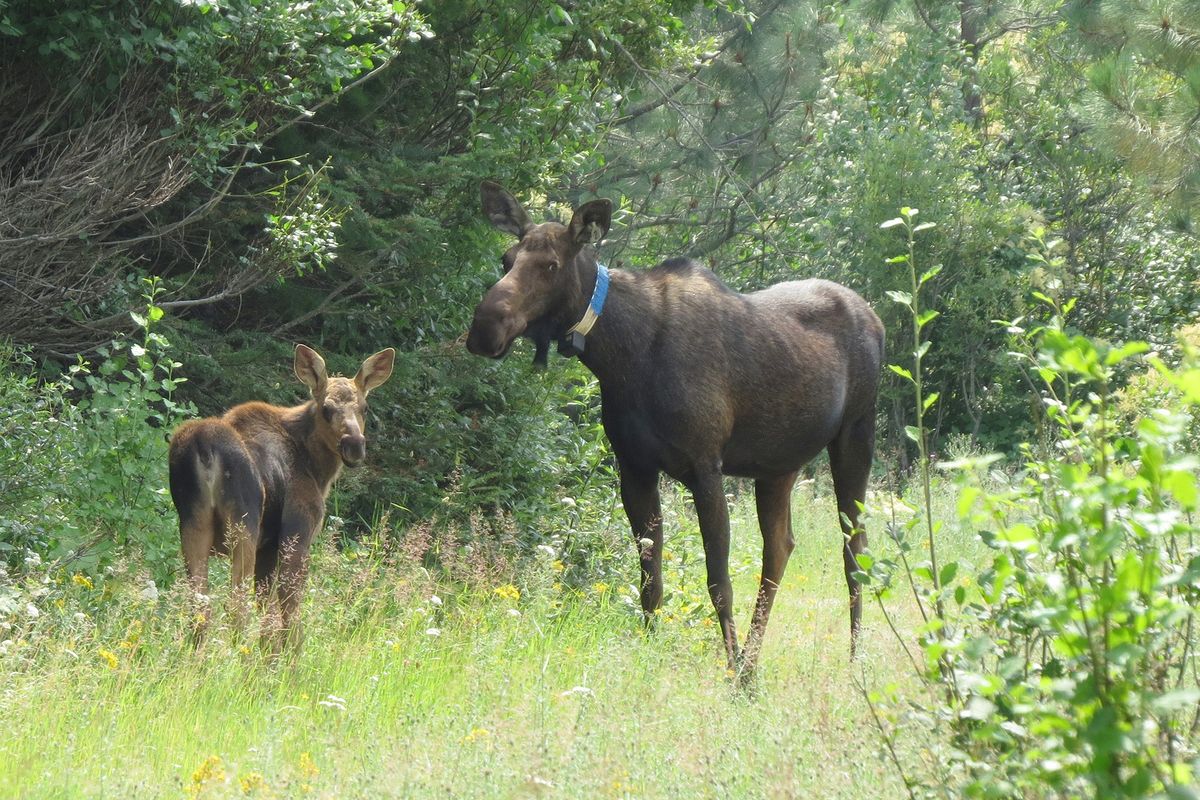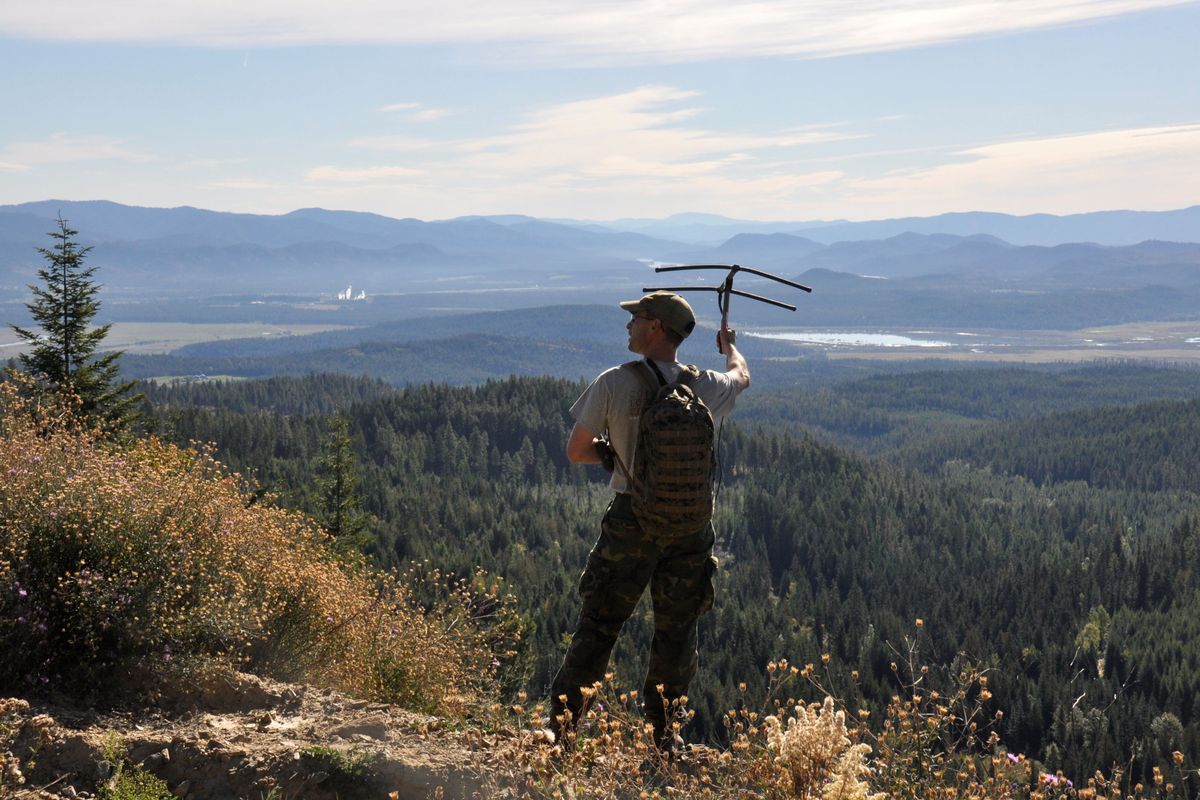Wild moose chase: Researchers tracking 25 collared moose in NE Washington
Wildlife researcher James Goerz, a University of Montana graduate assistant, tracks a radio-collared moose in Pend Oreille County for a state moose study. (Rich Landers)Buy a print of this photo
James Goerz was so close he could hear her chewing as she browsed. It seemed impossible that he couldn’t put his eyes on the moose, the largest member of the deer family.
The cow had been just 50-70 yards away for hours in an old northeastern Washington clearcut, yet he couldn’t see an ear, a leg or even a patch of dark hair.
“This is a lesson in how many critters we pass without knowing what’s there,” the wildlife researcher said as he listened to blips from his radio receiver.
A Global Positioning System collar on the cow had beamed its location to a satellite and down to his laptop computer at 2 p.m. the previous day.
“The GPS is programmed to give only one location a day to prolong the battery life for at least four years,” he said.
He had driven along Pend Oreille County logging roads early the next morning toward the location until he got a signal from the collar’s constantly pulsing radio transmitter.
He bushwhacked through the forest holding a cumbersome antenna to follow the signal until he zeroed in on the moose. It was just across a brushy, timbered draw and moving, but he couldn’t visually confirm whether its two young calves were still alive.
“Calf survival is one of the elements of the study, but I don’t want to stress her,” he said, sneaking quietly like a hunter. “It’s already starting to get warm out. Moose are prone to overheating.”
The moose was one of 28 adult cows Washington Department of Fish and Wildlife biologists had tranquilized last winter in order to attach transmitting collars for the first major research on the state’s moose herd.
The agency aims to collar another 25 moose this winter to provide a bigger sample for the five-year study.
Moose, which have infiltrated from Canada and Idaho, are newcomers to the state compared with most other big-game species. The first confirmed moose sighting was made in Pend Oreille County in the early 1950s. Surveys in the early ’70s estimated a population of about 60 moose.
The first hunting season was opened in 1977 with three once-in-a-lifetime bull-only permits. This year, with the state harboring roughly 1,000 moose, 144 moose hunting permits were awarded in a lottery drawing.
Virtually all of the moose are on the east side of the state and most of them in the northeast quadrant.
Moose are in serious decline in other parts of the country – down as much as 70 percent in Minnesota. Major studies are underway there as well as in several states including Montana as scientists investigate potential factors such as tick infestations, predators and climate change.
“We see moose still expanding range in Washington and haven’t detected a decline, but we wanted to get a handle on what we have and what might be going on,” said Rich Harris, the state’s manager for special big-game species.
Three of the 28 moose collared last winter perished before the spring calving season. One died from a capture-related injury; one was in poor condition when captured and apparently died from malnutrition. The cause of the third death could not be determined.
None of the collared moose has been shot by hunters so far this season. “It wouldn’t be illegal for a hunter with a tag to take one,” Harris said. “Of course, we’d ask that they return the expensive collar to us.”
The 25 surviving cows produced 17 calves including one set of twins. One of the calves was lost early, probably to a mountain lion or black bear, said Goerz (pronounced Gertz).
“I put out trail cams where the collared moose are hanging out and we documented a lot of cougar and bear activity in that area,” said the University of Montana wildlife graduate assistant in charge of monitoring.
Tree-climbing skills are a prerequisite for his job.
“I’ve put out 20 cameras, high in trees when I can,” he said. “Two cameras have been stolen as well as several SD cards.”
Goerz served in the Marine Corps for two tours in the Middle East, including one in Iraq, before choosing wildlife biology as the next chapter in his life.
“I’ve always been fascinated by wildlife as a hunter and hiker,” he said. “This is a dream come true to be a part of this study.”
Goerz moves quickly and quietly on trails. His pace does not slow when moving through blowdowns or uphill through thick brush on overgrown skid roads.
He and a couple other researchers are monitoring collared moose from just north of Spokane to the Chewelah area.
“You quickly learn that these moose are all individuals,” he said.
One cow has ranged from Mount Spokane northeast across the state line to nearly to Sandpoint. “In one spurt it covered 40 miles in four days,” he said.
Another moose has remained within a half-mile of where it was collared last winter.
“Cows seem to have more fidelity for a calving area where they successfully raised their young the previous year,” he said.
The study will give state wildlife managers insights into population growth rates, leading causes of moose deaths, which habitat moose are using most and which areas they avoid.
“We don’t do this in a vacuum,” Goerz said. “All Western states’ wildlife managers and researchers get together occasionally to talk about their research and collaborate.”
The uptick in research already seems to be breaking stereotypes of moose habitat. “They’re not just linked to wet areas,” he said. “They also associate with ponderosa pine forests.”
They might look a bit goofy with long, gangly legs and a snout that overhangs like a limp boxing glove, but moose fascinate Goerz.
“Some moose are skittish; some won’t leave you alone once they detect you. I had to scare off one collared cow. She was being a pest,” he said.
“They are a surprisingly complex animal,” he said after watching calves gain 2-3 pounds a day this summer and seeing bulls grow new sets of antlers at rates sometimes visible on a daily basis.
“It’s not a study focus, but I can tell you there are lots of bulls in northeastern Washington, and some real big ones.”
Occasionally, the researchers do aerial surveys, but most effort is on the ground.
“The public can help us a lot by reporting their sightings of collared moose,” Goerz said, noting that he’s left moose-study brochures with website and phone information at many shops and restaurants in northeastern Washington.
The only collared cow to deliver twins this spring eluded Goerz all morning on that field trip to document whether the calves were still alive. He left them alone during the heat of the day and returned in the late afternoon.
“Moose are most active around dusk,” he said, tracking her down again by her radio signal.
He found where she had bedded. Tracks and other sign indicated there was at least one calf with her.
“Three piles of calf poop,” he noted at the scene. “That’s a lot for one calf.”
He took samples of each pile. “If I don’t get a sighting, I can send these samples in for DNA testing to determine if they’re from different calves. But I’d rather get a sighting to save $80-$120 on lab costs.”
After some serious bushwhacking, taking wind direction into account and looping into a draw, he once again got within about 50 yards of the cow but couldn’t see her. So he sat like a hunter waiting for a shot.
Most of the calves are born around June 1. They are most vulnerable to death in the first four months as a result of predators, sickness or abandonment.
Although researchers were able to confirm 17 calves born to collared cows this spring, it’s possible that predators quickly killed more than one before they were documented.
“We’re not doing any capturing and collaring of calves,” Goerz said. “Other states have taken the bullet for us on that with results that indicate calves don’t survive well if they’ve been captured.” Apparently it makes them more susceptible to abandonment or predation.”
By sheer persistence, Goerz eventually was able to confirm that both of the cow’s calves were alive.
“It’s amazing that we still have 25 cows and 16 calves well into the fall,” Goerz said Thursday. “It’s too early for any conclusions. Some could die in the next month. But it’s an encouraging early indicator that Washington’s moose population may be healthy.”


